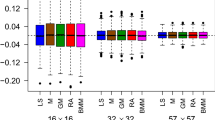Abstract
This paper addresses an image prediction problem focused on images with no identifiable objects. In it, we present several approaches to predict the next image of a given sequence, when the image lacks the well-defined objects, such as meteorological maps or satellite imagery. In these images no clear borders are present, and any object candidate moves, changes, appears and disappears in any image. Nevertheless, this evolution, though unrestricted, is gradual and, hence, prediction looks feasible. One of the approaches presented here, based on a spatio-temporal autoregressive (STAR) model, offers good results for these kinds of images.
The main contribution of this paper is to adapt spatio-temporal models to an image prediction problem.
As a byproduct of this research, we have achieved a new image compression method, suitable for images without defined shapes.
Similar content being viewed by others
References
Bakker, R., Schouten, J.C., Giles, C.L., Takens, F., van den Bleek, C.M.: Learning chaotic attractors. Neural Comput. 12, 2355–2383 (2000)
Beichel, R., Bischof, H., Leberl, F., Sonka, M.: Robust active appearance models and their application to medical image analysis. IEEE Trans. Med. Imag. 24(9), 1151–1169 (2005)
Bors, A.G., Pitas, I.: Prediction and tracking of moving objects in image sequences. IEEE Trans. Image Process. 9(8), 1441–1445 (2000)
Box, G.E.P., Jenkins, F.M.: Time Series Analysis: Forecasting and Control. Holden-Day, Oakland, CA (1976)
Butcher, D., Cootes, T.F., Courtney, P., Gill, M., Lithgow, G.J.: Model-based image analysis of a model organism for life science research. In: Proceedings of 7th International Conference on Image Processing and its Applications 1(465), 392–396 (1999)
Cootes, T.F., Eduards, G., Taylor, C.J.: Comparing active shape models with active appearance models. In: Proceedings of the 10th British Machine Vision Conference, pp. 173–182 (1999)
Cootes, T.F., Edwards, G.J., Taylor, C.J.: Active appearance models. IEEE Trans. Pattern Anal. Mach. Intell. 23(6), 681–685 (2001)
Cootes, T.F., Taylor, C.J.: Statistical models of appearance for medical image analysis and computer vision. In: Proceedings of SPIE, The International Society for Optical Engineering 4322(1), 236–248 (2001)
Cootes, T.F., Taylor, C.J., Cooper, D.H., Graham, J.: Active shape models: their training and application. Comput. Vis. Image Understand. 61, 38–59 (1995)
Crespo, J.L.: Procesamiento paralelo y distribuido aplicado a la simulación de sistemas. Dissertation, Universidad de Cantabria (1992)
Crespo, J.L., Bernardos, P., Zorrilla, M., Mora, E.: Preprocessing phase in the pietsi project (prediction of time evolution images using intelligent systems). In: 9th International Conference on Computer Aided Systems Theory: Eurocast 2003, Lecture Notes in Computer Science, vol. 2809, pp. 651–660. Springer, Berlin Heidelberg New York (2004)
Crespo, J.L., Bernardos, P., Zorrilla, M., Mora, E.: Meteorological image descriptors. In: 10th International Conference on Computer Aided Systems Theory: Eurocast 2005, Lecture Notes in Computer Science, vol. 3643, pp. 101–110. Springer, Berlin Heidelberg New York (2005)
Danyali, H., Mertins, A.: Flexible, highly scalable, object-based wavelet image compression algorithm for network applications. IEE Proc. Vis. Image Signal Process. 151(6), 498–510 (2004)
Department of Forestry, Michigan State University: An integrated enviroment for analyzing STARMA models. http://fried.for.msu.edu/∼ieast/what-is-STARMA/STARMA-models.html. Cited (2006)
Deutsch, S.J., Ramos, J.A.: Space-time modeling of vector hydrologic sequences. Water Resour. Bull. 22, 967–980 (1986)
Fahlman, S.: The recurrent cascade-correlation architecture. Tech. Rep. CMU-CS-91-00, Carnegie-Mellon University, Pittsburgh, PA (1991)
Egmont-Petersen, M., de Ridder, D., Handels, H.: Image processing with neural networks – a review. Pattern Recogn. 35, 2279–2301 (2002)
Erkelens, J.S.: Autoregressive modelling for speech coding: estimation, interpolation and quantisation. Tech. Rep., Delft Center for Systems and Control at the Delft University of Technology, Delft, Netherlands (2005)
Hill, A., Cootes, T.F., Taylor, C.J.: Active shape models and the shape approximation problem. Image Vis. Comput. 14(8), 601–608 (1996)
Jordan, M.I.: Attractor dynamics and parallelism in a connectionnist sequential machine. In: Proceedings of the 8th Annual Conference of the Cognitive Science Study (1986)
Lapedes, A., Farber, R.: Nonlinear signal processing using neural networks: prediction and system modelling. Tech. Rep. LA-UR87-2662, Los Álamos National Laboratory, NM (1987)
Marshall, J.A., Srikanth, V.: Curved trajectory prediction using a self-organizing neural network. Int. J. Neural Syst. 10(1), 59–70 (2000)
Mincer, J., Zarnowitz, V.: The evaluation of economic forecasts. Economic Forecasts and Expectation, National Bureau of Economic Research, New York (1969)
Minsky, M.L.: Computation: Finite and Infinite Machines. Prentice-Hall, New York (1967)
Mitiche, L., Adamou-Mitiche, A.B.H., Berkani, D.: Low-order model for speech signals. Signal Process. 84(10), 1805–1811 (2004)
Pace, R.K., Barry, R., Clapp, J., Rodriguez, M.: Spatio-temporal autoregressive models of neighborhood effects. J. Real Estate Finance Econ. 17(1), 15–33 (1998)
Pearlmutter, B.A.: Learning state space trajectories in recurrent neural networks. Neural Comput. 1, 263–269 (1989)
Pfeifer, P.E., Deutsch, S.J.: A three-stage iterative procedure for space-time modelling. Technometrics 22(1), 35–47 (1980)
Pineda, F.J.: Recurrent backpropagation and the dynamical approach to adaptive neural computation. Neural Comput. 1, 161–172 (1989)
Rao, T.S., Antunes, A.M.C.: Spatio-temporal modelling of temperature time series: a comparative study. IMA Vol. Math. Appl. 139, 123–150 (2004)
Szummer, M., Picard, R.W.: Temporal texture modelling. In: Proceedings of the 1996 IEEE International Conference on Image (1996)
Weigend, A.S., Gershenfeld, N.A.: Time Series Prediction: Forecasting the Future and Understanding the Past. Addison-Wesley, Boston (1993)
Williams, R.J., Zipser, D.A.: Learning algorithm for continually running fully recurrent neural networks. Neural Comput. 1(2), 270–280 (1989)
Author information
Authors and Affiliations
Corresponding author
Rights and permissions
About this article
Cite this article
Crespo, J., Zorrilla, M., Bernardos, P. et al. A new image prediction model based on spatio-temporal techniques . Visual Comput 23, 419–431 (2007). https://doi.org/10.1007/s00371-007-0114-y
Published:
Issue Date:
DOI: https://doi.org/10.1007/s00371-007-0114-y




